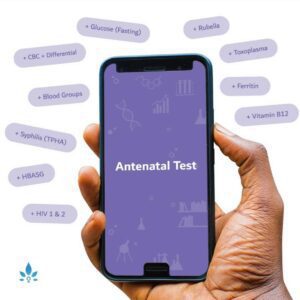Charting Your Basal Body Temperature (BBT)

- Charting your basal body temperature (BBT) is a way to understand where you are in your menstrual cycle, helping you to predict the exact point of ovulation.
- Basal body temperature is your body temperature when it is at rest and it increases by around 0.3 – 0.6°C during ovulation.
- Measuring basal body temperature can be done orally, vaginally or rectally and is best taken each morning, after sleep.
- Vaginal monitoring is the most precise method with 99% accuracy and can be done using the OvuSense vaginal thermometer alongside the Nabta app.
A female’s menstrual cycle lasts from the first day of menstruation to the day before her next period starts. For women who have a very regular 28 day cycle, ovulation will usually occur around day 15, which is approximately 2 weeks before the start of the next menstrual cycle. However, a ‘normal’ menstrual cycle can vary from 21 to 40 days, so determining the exact point at which ovulation occurs is not that simple. It is, however, possible to use physiological cues to determine the likely start of ovulation; the body produces certain physical signs in response to fluctuating hormone levels and by accurately monitoring these, a female may be able to deduce when she is at her most fertile. Approaches such as observing cervical mucus and measuring Basal Body Temperature (BBT) are types of fertility awareness-based methods that can be used for natural family planning.
What is Basal Body Temperature?
BBT is the temperature of the person at rest. During ovulation, the BBT usually rises by 0.3 – 0.6°C (0.5 – 1.0°F). By accurately recording the BBT every day, a woman may be able to determine if and when ovulation occurred.
Typical temperature fluctuations during a normal cycle:
- The follicular phase of the cycle is the time before ovulation. BBT is influenced by oestrogen levels and progesterone levels are low. Normal BBT range: 36.4 – 36.8°C (97 – 98°F).
- One day before ovulation there is a peak in luteinising hormone. BBT reaches its lowest point, known as the nadir.
- After ovulation, progesterone levels increase up to 10-fold.Temperature increases 0.3 – 0.6°C (0.5 – 1.0°F) and typically remains above 37°C for the next 10-14 days. This is known as the luteal phase of the cycle.
- If fertilisation does not occur, progesterone levels and BBT both reduce 1-2 days before menstruation starts.
It is important to always measure BBT in the same way, orally, vaginally, or rectally, using the same thermometer. Measuring under the armpit is not considered to be accurate enough. The best time to record BBT is first thing in the morning before undertaking any physical activity. Ideally, BBT measurements should be taken after at least 3-4 hours sleep.
BBT can be affected by increased stress, illness, medication use, alcohol consumption and changes in time zone/circadian rhythm. It is also futile to take measurements if you are using hormonal contraceptives, as the synthetic hormones will disrupt the normal ovulatory cycle.
What can you use basal body temperature for?
As a means of contraception, recording BBT is not without its drawbacks. At best it predicts peak fertility, with the rise in temperature indicating that ovulation has occurred. To completely avoid pregnancy, a female would need to abstain from intercourse from the start of menstruation until 3-4 days after the rise in BBT.
The most valuable use for BBT plotting is perhaps as a tool for determining the best time to have intercourse if trying to conceive. For those women who have regular periods, measuring BBT for 3-4 cycles can give a fairly accurate prediction of which days they are most fertile. Male sperm can survive for 5-7 days inside the female reproductive tract, but once ovulation triggers the release of the female egg from the ovaries, the egg only has a 24 hour period of viability. This means that a female is fertile from 5 days before ovulation, to 2 days afterwards. Outside of this window, she cannot conceive. By the time the BBT spike is seen, the female is reaching the end of her fertile period for that month.
Can measuring basal body temperature help fertility?
The major benefits to using BBT to identify ovulation are that it is low-cost, easily accessible (the only equipment you need are a thermometer and chart paper to plot your readings) and non-invasive.
One means of improving the efficacy of BBT is to combine it with other fertility awareness-based methods, such as the cervical mucus method. This method is based on the theory that cervical secretions change throughout the menstrual cycle. Using these two approaches in combination is known as the symptothermal approach.
BBT can also be tracked alongside using our OvuSense device, which is a realtime fertility monitor, aimed to predict ovulation with 99% accuracy.
The Nabta App can be used to record the Basal Body Temperature and store and plot the data.
Nabta is reshaping women’s healthcare. We support women with their personal health journeys, from everyday wellbeing to the uniquely female experiences of fertility, pregnancy, and menopause.
Get in touch if you have any questions about this article or any aspect of women’s health. We’re here for you.
Sources:
- NHS Choices, NHS, https://www.nhs.uk/conditions/contraception/natural-family-planning/.
- “Fertility Awareness-Based Methods of Family Planning.” ACOG, Women’s Health Care Physicians, https://www.acog.org/Patients/FAQs/Fertility-Awareness-Based-Methods-of-Family-Planning.
- Pallone, S. R., and G. R. Bergus. “Fertility Awareness-Based Methods: Another Option for Family Planning.” The Journal of the American Board of Family Medicine, vol. 22, no. 2, 2009, pp. 147–157., doi:10.3122/jabfm.2009.02.080038.
- Su, Hsiu-Wei, et al. “Detection of Ovulation, a Review of Currently Available Methods.” Bioengineering & Translational Medicine, vol. 2, no. 3, 16 May 2017, pp. 238–246., doi:10.1002/btm2.10058.













































